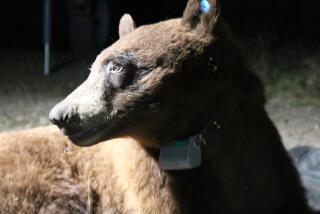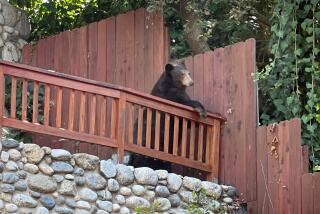Woman who had bear killed says she was trying to protect her kids
- Share via
Julie Faith Strauja tried everything she could conceive of — a water hose, pepper spray, loud yells — to chase off a bear after it repeatedly barged into her home in the San Bernardino Mountains, terrifying her and her three young children.
She locked up her trash after the bear got into her garage last month and was alarmed when she arrived home with her children, ages 5, 6 and 9, on July 29 to discover the bear inside her kitchen. She called 911. And when a game warden came to her A-frame cabin in the small community of Forest Falls and found damage and fur on the windows, she issued a permit to kill the animal.
The bear returned later that night, entering through a bathroom window. The next day, Strauja called a friend who is a hunter to keep watch. When the bear charged toward the house again sometime before 2 a.m. on July 31, he shot and killed the creature.
Since then, Strauja, 34, said she has faced an intense backlash from some residents of Forest Falls, about 75 miles east of Los Angeles, as well as harsh criticism and threats on social media.
But she doesn’t regret her actions.
“It was a decision I had to make for the safety and welfare of my children and my home,” Strauja told The Times. “I tried to use non-lethal ways of dealing with him. But nothing was stopping him, and I just didn’t think there was any other option.”
State wildlife officials said Strauja did nothing wrong.
“The bear was inside the house, which satisfies every requirement under state law and policy for it to be destroyed,” said Andrew Hughan, a spokesman for the California Department of Fish and Wildlife.
Wildlife authorities said there has been no dramatic rise in black bear complaints in recent years despite predictions that California’s persistent drought would send droves of hungry animals into mountain communities.
Instead, the level of human-wildlife contact has been “pretty normal,” Hughan said. “We thought the drought was going to be catastrophic, with all kinds of wildlife in houses and swimming pools, but it just didn’t happen, which is good for everyone.”
Hughan suspects such encounters are getting more attention not because they are more frequent but because of an increasing number of photos, videos and other accounts being shared on social media.
Also garnering media coverage recently was a video posted to Facebook by a man who found a mother bear and her cubs inside his Mammoth Lakes house.
State officials issue hundreds of depredation permits each year to California residents allowing them to kill bears, mountain lions and other wild animals if they damage their property or pose a threat to life and safety. The Department of Fish and Wildlife issued 449 permits to kill black bears in 2014, the most recent year for which statistics were available.
Strauja, an avowed animal lover who moved to Forest Falls last month, called it “a tragedy that he lost his life” and said she wasn’t prepared for the harsh reaction she would face.
“There kind of was a mob mentality,” she said. “People walking by my house yelling ‘bear killer’ and obscenities.”
Strauja collected screenshots of a series of threatening and expletive-laden Facebook messages criticizing her over the killing of the bear. Some included her home address. Others called her a “flatlander” with “no business living on the hill,” and vowed to run her out of town and “make her life a living hell.”
Forest Falls resident Alycia Wheeler, 48, said in an interview that she was “crushed” to learn of the killing when she saw a photo of the dead bear posted on Facebook. She recognized it as the animal she had seen roaming her yard almost daily and had named Big Red for the distinct color of its fur.
Wheeler doesn’t blame Strauja but worries she did not exhaust all other options before going to the extreme of killing the animal.
“We need to protect people, but we also need to protect the bears,” said Wheeler, who has started an online campaign to raise money for educational materials, signs, bear-proof trash cans and other tools to prevent fatalities in the future.
“People who are visitors or they’re new to the area, they don’t understand that we cohabitate with bears — that’s just the way it is up here,” Wheeler said.
Hughan, of the Department of Fish and Wildlife, advised residents in bear country to take all the precautions they can, such as locking up trash bins, to keep the animals away from their homes.
“Once a bear is habituated, once it starts eating people food and going into houses, it’s not going to unlearn that behavior,” Hughan said. “This is not a bear problem. This is a people problem.”
Hughan also urged the public not to “rush to judgment in cases like this if you don’t know the facts. If you had a bear in your house and your children were with you, put yourselves in her shoes.”
ALSO
Fast-moving brush fire burns in San Bernardino Mountains
Mother and 4-year-old daughter shot to death in Long Beach; police have no suspects or motive
2 found dead at the base of seaside cliffs in San Pedro are identified by coroner’s office
UPDATES:
6:40 p.m.: This article was updated and rewritten throughout.
This article was originally published at 5 a.m.
More to Read
Sign up for Essential California
The most important California stories and recommendations in your inbox every morning.
You may occasionally receive promotional content from the Los Angeles Times.











